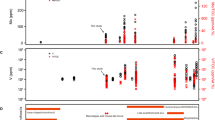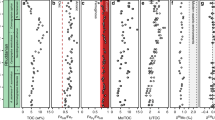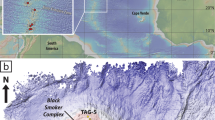Abstract
Sedimentary rocks deposited across the Proterozoic–Phanerozoic transition record extreme climate fluctuations, a potential rise in atmospheric oxygen or re-organization of the seafloor redox landscape, and the initial diversification of animals1,2. It is widely assumed that the inferred redox change facilitated the observed trends in biodiversity. Establishing this palaeoenvironmental context, however, requires that changes in marine redox structure be tracked by means of geochemical proxies and translated into estimates of atmospheric oxygen. Iron-based proxies are among the most effective tools for tracking the redox chemistry of ancient oceans3,4. These proxies are inherently local, but have global implications when analysed collectively and statistically. Here we analyse about 4,700 iron-speciation measurements from shales 2,300 to 360 million years old. Our statistical analyses suggest that subsurface water masses in mid-Proterozoic oceans were predominantly anoxic and ferruginous (depleted in dissolved oxygen and iron-bearing), but with a tendency towards euxinia (sulfide-bearing) that is not observed in the Neoproterozoic era. Analyses further indicate that early animals did not experience appreciable benthic sulfide stress. Finally, unlike proxies based on redox-sensitive trace-metal abundances1,5,6, iron geochemical data do not show a statistically significant change in oxygen content through the Ediacaran and Cambrian periods, sharply constraining the magnitude of the end-Proterozoic oxygen increase. Indeed, this re-analysis of trace-metal data is consistent with oxygenation continuing well into the Palaeozoic era. Therefore, if changing redox conditions facilitated animal diversification, it did so through a limited rise in oxygen past critical functional and ecological thresholds, as is seen in modern oxygen minimum zone benthic animal communities7,8,9.
This is a preview of subscription content, access via your institution
Access options
Subscribe to this journal
Receive 51 print issues and online access
$199.00 per year
only $3.90 per issue
Buy this article
- Purchase on Springer Link
- Instant access to full article PDF
Prices may be subject to local taxes which are calculated during checkout



Similar content being viewed by others
References
Lyons, T. W., Reinhard, C. T. & Planavsky, N. J. The rise of oxygen in Earth's early ocean and atmosphere. Nature 506, 307–315 (2014)
Lenton, T. M., Boyle, R. A., Poulton, S. W., Shields-Zhou, G. A. & Butterfield, N. J. Co-evolution of eukaryotes and ocean oxygenation in the Neoproterozoic era. Nature Geosci. 7, 257–265 (2014)
Poulton, S. W. & Canfield, D. E. Ferruginous conditions: a dominant feature of the ocean through Earth's history. Elements 7, 107–112 (2011)
Lyons, T. W. & Severmann, S. A critical look at iron paleoredox proxies: new insights from modern euxinic marine basins. Geochim. Cosmochim. Acta 70, 5698–5722 (2006)
Reinhard, C. T. et al. Proterozoic ocean redox and biogeochemical stasis. Proc. Natl Acad. Sci. USA 110, 5357–5362 (2013)
Partin, C. A. et al. Large-scale fluctuations in Precambrian atmospheric and oceanic oxygen levels from the record of U in shales. Earth Planet. Sci. Lett. 369–370, 284–293 (2013)
Sperling, E. A. et al. Oxygen, ecology, and the Cambrian radiation of animals. Proc. Natl Acad. Sci. USA 110, 13446–13451 (2013)
Levin, L. A. Oxygen Minimum Zone benthos: adaptation and community response to hypoxia. Oceanogr. Mar. Biol. Annu. Rev. 41, 1–45 (2003)
Woulds, C. et al. Oxygen as a control on seafloor biological communities and their roles in sedimentary carbon cycling. Limnol. Oceanogr. 52, 1698–1709 (2007)
Canfield, D. E. A new model for Proterozoic ocean chemistry. Nature 396, 450–453 (1998)
Shen, Y., Knoll, A. H. & Walter, M. R. Evidence for low sulphate and anoxia in a mid-Proterozoic marine basin. Nature 423, 632–635 (2003)
Canfield, D. E., Poulton, S. W. & Narbonne, G. M. Late-Neoproterozoic deep-ocean oxygenation and the rise of animal life. Science 315, 92–95 (2007)
Planavsky, N. J. et al. Widespread iron-rich conditions in the mid-Proterozoic ocean. Nature 477, 448–451 (2011)
Sperling, E. A. et al. Redox heterogeneity of subsurface waters in the Mesoproterozoic ocean. Geobiology 12, 373–386 (2014)
Canfield, D. E. et al. Ferruginous conditions dominated later Neoproterozoic deep-water chemistry. Science 321, 949–952 (2008)
Johnston, D. T. et al. Searching for an oxygenation event in the fossiliferous Ediacaran of northwestern Canada. Chem. Geol. 362, 273–286 (2013)
Alroy, J. et al. Phanerozoic trends in the global diversity of marine invertebrates. Science 321, 97–100 (2008)
Canfield, D. E. Reactive iron in marine sediments. Geochim. Cosmochim. Acta 53, 619–632 (1989)
Raiswell, R. & Canfield, D. E. Sources of iron for pyrite formation in marine sediments. Am. J. Sci. 298, 219–245 (1998)
Erwin, D. H. et al. The Cambrian conundrum: early divergence and later ecological success in the early history of animals. Science 334, 1091–1097 (2011)
Sperling, E. A., Halverson, G. P., Knoll, A. H., Macdonald, F. A. & Johnston, D. T. A basin redox transect at the dawn of animal life. Earth Planet. Sci. Lett. 371–372, 143–155 (2013)
Mills, D. B. et al. Oxygen requirements of the earliest animals. Proc. Natl Acad. Sci. USA 111, 4168–4172 (2014)
Martin, W. et al. Early cell evolution, eukaryotes, anoxia, sulfide, oxygen, fungi first (?), and a tree of genomes revisited. IUBMB Life 55, 193–204 (2003)
Vaquer-Sunyer, R. & Duarte, C. M. Sulfide exposure accelerates hypoxia-driven mortality. Limnol. Oceanogr. 55, 1075–1082 (2010)
Planavsky, N. J. et al. Low Mid-Proterozoic atmospheric oxygen levels and the delayed rise of animals. Science 346, 635–638 (2014)
Sepkoski, J. J., Jr Ten years in the library: new data confirm paleontological patterns. Paleobiology 19, 43–51 (1993)
Algeo, T. J. & Rowe, H. Paleoceanographic applications of trace-metal concentration data. Chem. Geol. 324–325, 6–18 (2011)
Dahl, T. W. et al. Devonian rise in atmospheric oxygen correlated to the radiation of terrestrial plants and large predatory fish. Proc. Natl Acad. Sci. USA 107, 17911–17915 (2010)
Rhoads, D. C. & Morse, J. W. Evolutionary and ecologic significance of oxygen-deficient marine basins. Lethaia 4, 413–428 (1971)
Leavitt, W. D., Halevy, I., Bradley, A. S. & Johnston, D. T. Influence of sulfate reduction rates on the Phanerozoic sulfur isotope record. Proc. Natl Acad. Sci. USA 110, 11244–11249 (2013)
Bergman, N. M., Lenton, T. M. & Watson, A. J. COPSE: a new model of biogeochemical cycling over Phanerozoic time. Am. J. Sci. 304, 397–437 (2004)
Berry, W. B. & Wilde, P. Progressive ventilation of the oceans; an explanation for the distribution of the lower Paleozoic black shales. Am. J. Sci. 278, 257–275 (1978)
Belcher, C. M. & McElwain, J. C. Limits for combustion in low O2 redefine paleoatmospheric predictions for the Mesozoic. Science 321, 1197–1200 (2008)
Acknowledgements
We thank D. Cole, A. Masterson, E. Beirne, G. Resendiz, A. Miller and W. Mai for laboratory assistance, E. Smith, T. Petach, M. Laflamme, S. Darroch, P. Myrow, J. Strauss, C. Carbone and G. Narbonne for field assistance, L. Levin, P. Girguis, C. Frieder, L. Duncan, C. Partin, S. Darroch and U. Farrell for discussions, and E. Hammarlund, C. Scott, R. Raiswell, G. Gilleaudeau, S. Sahoo, Y. Shen, J. Creveling, T. Dahl, C. Partin and D. Stolper for providing raw data from published studies. E.A.S. is funded by Agouron Geobiology and NAI Postdoctoral Fellowships and by the NSF-EAR 1324095 grant to L. Levin. This work is supported by the NSF-EAR 1324095 grant to D.T.J. and by the NASA Astrobiology Institute (A.H.K. and F.A.M.).
Author information
Authors and Affiliations
Contributions
E.A.S. and D.T.J. conceived the project, E.A.S., A.S.M., B.C.G., G.P.H., F.A.M. and D.T.J. collected samples, E.A.S., A.S.M., B.C.G. and M.K. completed geochemical measurements, E.A.S. and C.J.W. compiled data and analysed the global data set, and E.A.S. wrote the paper with input from all co-authors.
Corresponding authors
Ethics declarations
Competing interests
The authors declare no competing financial interests.
Supplementary information
Supplementary Information
This file contains Supplementary Text and Data, Supplementary Figures 1-4, Supplementary Tables 1-7 and Supplementary References. (PDF 1592 kb)
Supplementary Data
This file contains Supplementary Dataset 1. (XLSX 638 kb)
Rights and permissions
About this article
Cite this article
Sperling, E., Wolock, C., Morgan, A. et al. Statistical analysis of iron geochemical data suggests limited late Proterozoic oxygenation. Nature 523, 451–454 (2015). https://doi.org/10.1038/nature14589
Received:
Accepted:
Published:
Issue Date:
DOI: https://doi.org/10.1038/nature14589
Comments
By submitting a comment you agree to abide by our Terms and Community Guidelines. If you find something abusive or that does not comply with our terms or guidelines please flag it as inappropriate.



